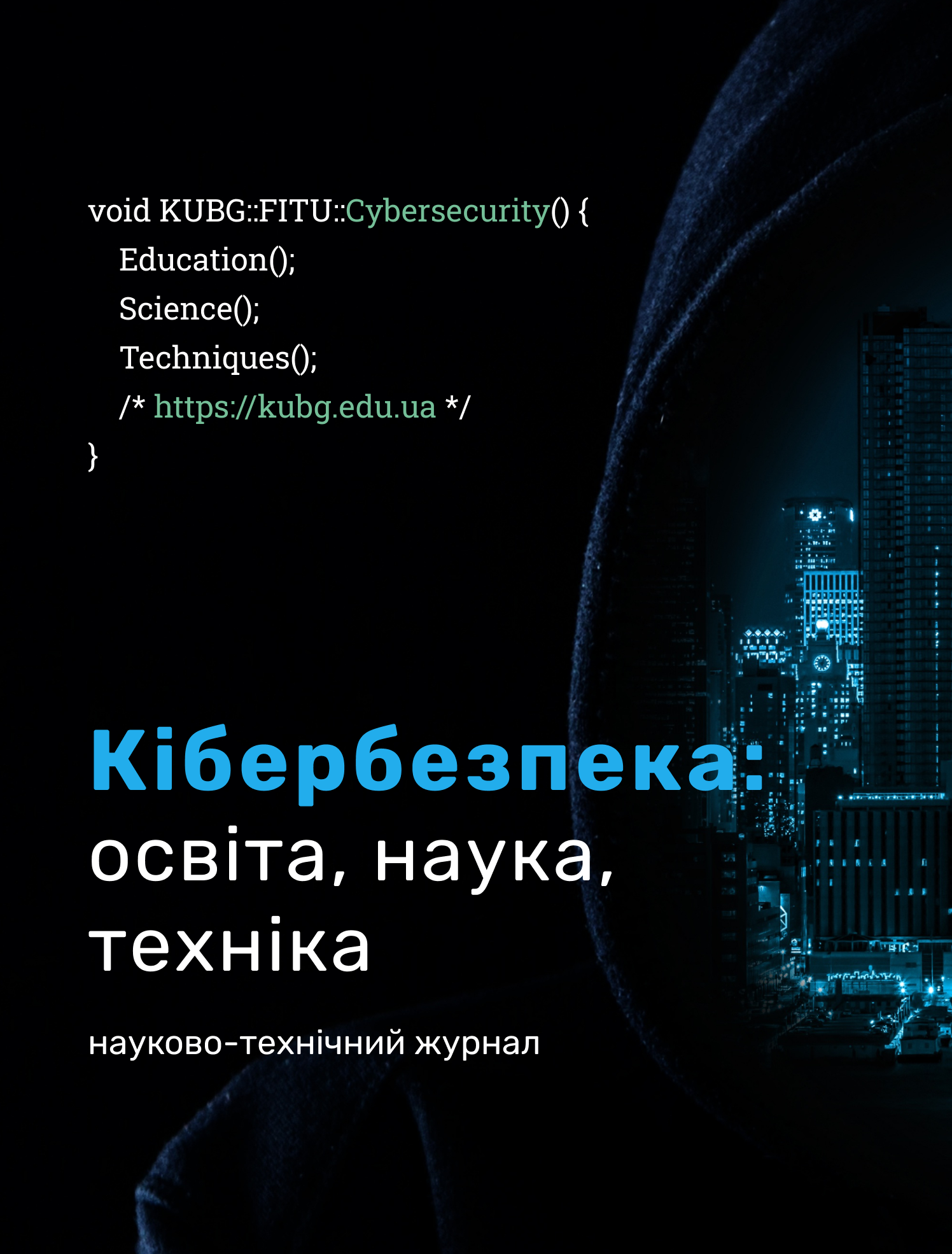АНАЛІЗ КІБЕРЗАГРОЗ В УМОВАХ СТРІМКОГО РОЗВИТКУ ІНФОРМАЦІЙНИХ ТЕХНОЛОГІЙ
DOI:
https://doi.org/10.28925/2663-4023.2024.23.225236Ключові слова:
кіберпростір; кібербезпека; кіберзагроза; кібервійна; кіберризик; вплив; ризик; міжнародні комунікації.Анотація
Анотація. В епоху цифрових технологій кібербезпека стала невід’ємним аспектом нашого життя. Зі зростанням залежності від технологій та інтернету люди, організації та суспільство в цілому стикаються з безпрецедентним рівнем кіберзагроз. Кібератаки стають все частішими, витонченішими та результативнішими, ставлячи під загрозу конфіденційну інформацію та важливі об’єкти критичної інфраструктури. Тому вкрай важливо розуміти мінливий ландшафт кіберзагроз і розробляти ефективні стратегії для протидії. Розглядається поточний стан кібербезпеки та викликів, з якими вона стикається. Висвітлюються аспекти підвищення кількості кібератак та їхньої зростаючої складності, через що традиційним заходам безпеки важко встигати за ними. Також розглядаються різні типи кіберзагроз в тому числі програми-вимагачі та атаки на основі підбору паролів. Крім того, розглядаються мотиви цих атак, які можуть варіюватися від фінансової вигоди до комерційного та політичного шпигунства і кібервійни. Розглядаються аспекти впливу нових технологій на кібербезпеку, які пропонують величезні переваги, але вони також створюють нові вектори атак, якими можуть скористатися кіберзлочинці, експлуатуючи новітні потенційні вразливості та ризики. Аналізуються глобальні тренди розвитку IoT та кібербезпеки за 20 років з 2004 до 2024 року, а також розвиток загроз та атак програм-вимагачів, особливо під час пандемії Covid-19, а також кібератак на основі зламу паролів і їх значного підвищення в 2023 році. Стаття надає всебічний огляд поточного стану кібербезпеки та викликів, з якими вона стикається. Вона підкреслює важливість прийняття цілісного підходу до кібербезпеки, який поєднує технологічні рішення з освітою, обізнаністю та міжнародним співробітництвом. Крім того, підкреслюється необхідність для організацій і окремих осіб зберігати пильність і адаптуватися до нових загроз і технологій. Працюючи разом, ми можемо створити безпечніше і надійніше цифрове майбутнє для всіх.
Завантаження
Посилання
Kryvoruchko, V., & Kostyk І. (2020). Information security strategy. Cyberhygiene. Cubersecurity. State security: materials of scientific seminars. Kyiv National Unoversity of Trade and Economics.
Li, Y., & Liu, Q. (2021) A comprehensive review study of cyber-attacks and cyber security; Emerging trends and recent development. Energy Reports, 7, 8176–8186. https://doi.org/10.1016/j.egyr.2021.08.126
Brantly A.F. (2016) The decision to attack: military and intelligence cyber decision-making. University of Georgia Press.
Yerina, A., Honchar, I., & Zaiets, S. (2021). Statistical Indicators of Cybersecurity Development in the Context of Digital Transformation of Economy and Society. Science and Innovation, 17(3), 3–13. https://doi.org/10.15407/scine17.03.003
Dmytruk, Y., et al. (2022). Cyberwar as a Variety of Information Wars. Ukrainian Cyber Space Protection. Electronic Professional Scientific Edition “Cybersecurity: Education, Science, Technique”, 4(16), 28–36. https://doi.org/10.28925/2663-4023.2022.16.2836
Gillis, A. (2023). Definition cyberwarfare. TechTarget. https://www.techtarget.com/searchsecurity/ definition/cyberwarfare
Laktionov, I., et al.. (2022). Research Tools for Protecting Internet Resources from Ddos-Attack During Cyberwar. Electronic Professional Scientific Edition “Cybersecurity: Education, Science, Technique”, 1(17), 91–111. https://doi.org/10.28925/2663-4023.2022.17.91111
Callejas, J., Afifi, A., & Lozinskiy, N. (2021). Cybersecurity in the united nations system organizations. United Nations. https://www.unjiu.org/sites/www.unjiu.org/files/jiu_rep_2021_3_english.pdf
Digital 2023: Global Overview Report — DataReportal – Global Digital Insights. (2023). DataReportal – Global Digital Insights. https://datareportal.com/reports/digital-2023-global-overview-report
Study Finds Internet Economy Grew Seven Times Faster Than Total U.S. Economy, Created Over 7 Million Jobs in the Last Four Years. (2021). IAB. https://www.iab.com/news/study-finds-internet-economy-grew-seven-times-faster/
Yerina, A., Honchar, I., & Zaiets, S. (2021). Statistical Indicators of Cybersecurity Development in the Context of Digital Transformation of Economy and Society. Science and Innovation, 17(3), 3–13. https://doi.org/10.15407/scine17.03.003
Li, Y., & Liu, Q., (2021). A comprehensive review study of cyber-attacks and cyber security; Emerging trends and recent developments. Energy Reports, 7, 8176–8186. https://doi.org/10.1016/j.egyr.2021.08.126
Columbus, L. (2020). 2020 Roundup Of Cybersecurity Forecasts And Market Estimates. Forbes magazine. https://www.forbes.com/sites/louiscolumbus/2020/04/05/2020-roundup-of-cybersecurity-forecasts-and-market-estimates/
Fox, J. (2023). Top Cybersecurity Statistics for 2024. Cobalt: Offensive Security Services. https://www.cobalt.io/blog/cybersecurity-statistics-2024
O. V. Kryvoruchko, T. M. Morozova, A. M. Desyatko, (2021). The Internet of Things is a new stage of IT development. Computer technologies of data processing.
Cybersecurity and the Internet of Things (IoT) | IDB. (n.d.). Institute for Defense and Business. https://www.idb.org/cybersecurity-and-the-internet-of-things/
Boiko, V. (2022). The global echo of the Russian-Ukrainian cyber confrontation. National Institute for Strategic Studies. https://niss.gov.ua/doslidzhennya/natsionalna-bezpeka/svitove-vidlunnya-rosiysko-ukrayinskoho-kiberprotystoyannya
Vityuk, I. (2023). How the SBU uses the latest technologies to protect the country’s cyber security. Ua.news. https://ua.news/ua/technologies/yak-sbu-zastosovuye-novitni-tehnologiyi-dlya-zahystu-kiberbezpeky-krayiny-poyasnyuye-nachalnyk-departamentu-kiberbezpeky-sbu-illya-vityuk
Alam, S. (2022). Cybersecurity: past, present and future. ResearchGate. https://www.researchgate.net/publication/361765615_Cybersecurity_Past_Present_and_Future
Tarhan, K. (2022). International Islamic University Malaysia, Historical development of cybersecurity studies: a literature review and its place in security studies. http://studiastrategiczne.amu.edu.pl/wp-content/uploads/2023/02/ps-2023-15-21.pdf
Weber, R., & Studer, E. (2016). Cybersecurity in the internet of things: legal aspects. Computer Law & Security Review, 32(5), 715–728. https://doi.org/10.1016/j.clsr.2016.07.002
Katagiri, N. (2022). Explaining cyberspace dynamics in the covid era. Global Studies Quarterly, 2(3). https://doi.org/10.1093/isagsq/ksac022
Microsoft Didital Defence Report 2021.
Microsoft Didital Defence Report 2022.
Microsoft Didital Defence Report 2023.
Kuznetsov, O., et al. (2018) . Periodic properties of cryptographically secure pseudorandom sequences. Applied Radio Electronics: Sci. J. 17(3, 4), 96–103.
Harrison, J., Toreini, E., & Mehrnezhad, M. (2023), A practical deep learning-based acoustic side channel attack on keyboards. Cornell University.
Hulak, H., et al. (2022). Vulnerabilities of Short Message Encryption in Mobile Information and Communication Systems of Critical Infrastructure Objects. Electronic Professional Scientific Edition “Cybersecurity: Education, Science, Technique”, 1(17), 145–158. https://doi.org/10.28925/2663-4023.2022.17.145158
Shevchenko, S., et al. (2022). Insiders and Insider Information: Essence, Threats, Activities and Legal Responsibility. Electronic Professional Scientific Edition “Cybersecurity: Education, Science, Technique”, 3(15), 175–185. https://doi.org/10.28925/2663-4023.2022.15.175185
Skitsko, O., et al. (2023). Threats and Risks of the Use of Artificial Intelligence. Electronic Professional Scientific Edition “Cybersecurity: Education, Science, Technique”, 2(22), 6–18. https://doi.org/10.28925/2663-4023.2023.22.618
Sokolov, V., & Skladannyi, P. (2023). Methodology for Assessing Comprehensive Damages from an Information Security Incident. Electronic Professional Scientific Edition “Cybersecurity: Education, Science, Technique”, 1(21), 99–120. https://doi.org/10.28925/2663-4023.2023.21.99120
Romaniuk, O., Skladannyi, P., & Shevchenko, S. (2022). Comparative Analysis of Solutions to Provide Control and Management of Privileged Access in the it Environment. Electronic Professional Scientific Edition “Cybersecurity: Education, Science, Technique”, 4(16), 98–112. https://doi.org/10.28925/2663-4023.2022.16.98112
Hulak, H., et al. (2020). Cryptovirology: Security Threats to Guaranteed Information Systems and Measures to Combat Encryption Viruses. Electronic Professional Scientific Edition “Cybersecurity: Education, Science, Technique”, 2(10), 6–28. https://doi.org/10.28925/2663-4023.2020.10.628
Опубліковано
Як цитувати
Номер
Розділ
Ліцензія
Авторське право (c) 2024 Олег Гайдук , Володимир Звєрєв

Ця робота ліцензується відповідно до Creative Commons Attribution-NonCommercial-ShareAlike 4.0 International License.




